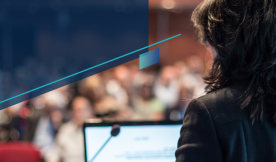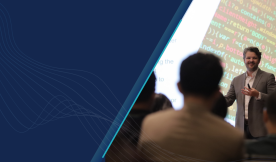GIST Mentors: Q&A with Cecily Kovatch
Cecily Kovatch is Managing Partner of Fueled for Growth, an independent consultancy helping companies solve challenges and develop future businesses. She also advises early stage startups and helps them grow into sustainable business entities. She has over 25 years leadership experience within energy & industrials, retail/consumer and financial services industries. She specializes in solving complex and ambiguous problems through innovative thinking with a focus on commercialization and sustainability. She is also an Adjunct Professor at Stevens Institute of Technology teaching “Entrepreneurial Thinking” to freshman engineers to help prepare them for successful careers. Cecily has a bachelor’s degree in Geology from Princeton University and an MBA from Harvard Business School. She is a frequent GIST startup mentor and advisor for VentureWell.
We asked energy innovator and GIST Startup Training instructor Cecily Kovatch of Fueled for Growth her thoughts on utilizing challenges as catalysts, why STEM is an important career option for women, and what innovators can do to keep themselves healthy and effective as they navigate the ups and downs of entrepreneurship.
GIST: This is a particularly challenging time for startups. You've said that "challenges and limitations can often be the best environment for innovation." How can early-stage innovators integrate this credo into their business structure and what does that end up looking like?
Cecily Kovatch: Challenges create opportunity. Instead of being discouraged by challenges, the best entrepreneurs will look for the opportunities that challenges create, and work to solve them. One of the main reasons startups fail is that they fail to make a product or service that the market needs. A challenge denotes an unmet need so you are off to a good start. Challenge also means that it’s probably not easy to solve. When the going gets tough, entrepreneurs who don’t have tenacity and “grit” will be weeded out, giving those with determination and adaptability the opportunity to innovate.
When thinking about how to solve a problem, the knowledge of an existing solution, as inferior as it may be, can influence and limit thinking. Often inventors end up merely making tweaks to an existing solution. This is more continuous improvement than the breakthrough innovation you need to set your product or service apart from the rest. When there are situations, like the COVID-19 pandemic, that create serious limitations, you are forced to think more creatively. For example, there’s a shortage of reagents that are vital to the testing process? Take traditional reagents out of the equation - how could you design a testing system that doesn’t require traditional reagents? In the industrial sector, employees may not be allowed on site to install hardware during the pandemic. How can you rethink the way equipment is installed if employees cannot physically be on site? Do you even need the hardware at all? Can a software-based solution using existing on-prem hardware be created? These limitations lead to new thinking and breakthrough innovations because you can no longer rely on the existing solution.
The Embrace Infant Warmer is a good example of this. Infant mortality rates in developing countries are very high. One reason for this is that premature babies do not have the bodyfat to keep themselves warm. An incubator could warm them to keep them alive as they develop, however women in rural areas often are not near a hospital, and often do not have access to reliable electricity. Most importantly, these developing regions cannot afford the 5-figure price tag per incubator. Taking electricity, a hospital environment and a high budget out of the picture, the Embrace team had to think completely differently about solving the problem. Tweaks to a traditional incubator would not meet the needs of the situation. The Embrace team developed what looked like a small sleeping bag to place the newborn baby in which had a pouch for a phase change material that could be heated in boiling water and thus keep the baby warm without electricity, without the hospital environment, and at a very affordable price of $25.
To get this type of revolutionary thinking, even if your business is in a situation where there are no immediate limitations, create a “crisis mentality”. Take something out of the equation. Ask “how could we accomplish X if we didn’t have ready access to Y” and see how differently you and your team think about solutions.
GIST: You teach Entrepreneurial Thinking at Stevens Institute of Technology. What advice do you have for women in emerging economies who are considering careers in STEM? Why should they also consider entrepreneurship in their career path?
Cecily Kovatch: In emerging economies, there are often very high unemployment rates. Additionally, recent graduates with little job experience are competing with experienced workers for jobs, and thus the outlook for the younger workforce is even more challenging. And now the COVID-19 pandemic is contributing to even higher unemployment rates. With entrepreneurship however, there is no limit. You create your own opportunity. You can increase the size of the pie in the economy, by addressing unmet needs and creating new markets. This is a win for you the entrepreneur, your future employees and your customers. And STEM skills are extremely important in both entrepreneurship and the corporate world. In addition to teaching you technical and analytical skills, studying STEM subjects teaches you critical thinking. Add entrepreneurial thinking on top of that base of skills and you can create and market products and services that meet the needs of your customers in an economically sustainable way and can scale.
GIST: What do you do to stay optimistic? Early-stage innovators often get beaten down by the realities of entrepreneurship. What advice do you have for them when facing adversity and maintaining a healthy outlook?
Cecily Kovatch: This is absolutely true! Adversity will come in many forms for an entrepreneur and often. It’s about resilience and grit. But it’s also about reenergizing yourself when things get challenging and growing. Use physical fitness as an example. Interval training is a fantastic way to get the most out of exercise in the shortest amount of time. Interspersing rest between spurts of intense work strains your muscles and when they rebuild during rest periods, they grow and get stronger in a sustainable manner. For work, try a similar approach. Interspersing time to refresh and rejuvenate between intense periods of focus works wonders. Doesn’t it often seem as if you get your best ideas when you are in the shower, or out on a walk in nature, not when plugging away for hours at a desk with artificial lighting? When I looked back on my most creative ideas, I found this was often the healthy pattern I was engaged in. When I later read The Power of Full Engagement by Jim Loehr and Tony Schwartz it solidified what I sensed worked for me. Intersperse short breaks in between intense periods of work to reenergize and get fresh ideas. Go for a short walk in the sun, grab a healthy snack, get up from your desk and chat with a co-worker about their passions outside of work. When you sit back down to tackle your work, you’ll have a renewed outlook and be more energized, creative, productive and optimistic.
GIST: This time has been very hard for startups. What specific advice do you have for startups during this pandemic?
Cecily Kovatch: Take time away from the day-to-day to think about how the pandemic has changed the world we live and work in. What new opportunities are in there for you and your company? Who ever thought a pandemic would lead to a run on toilet paper, exercise equipment and RV’s? After 3 months, it was hair dye that flew off the shelves as that’s about how long it takes hair to grow significantly to see the roots. What will be in demand after 9 months and 12 months for individuals, businesses, and local governments? Think through how you can anticipate and meet these new needs.
Also, take the time to reevaluate the risks to your business and address how you will mitigate them. A year ago, I bet very few startups had “pandemic” on their list of business risks. But hopefully many did have “supply chain disruption.” Think through all the risks to your business: distribution disruption, shipping delays, lack of childcare, school closings, increased healthcare insurance costs, and address how you will mitigate them. It (hopefully) won’t be a pandemic next time but how will you handle hurricanes, tornadoes and other extreme weather events, tax and tariff changes, a recession, cybersecurity threats, etc. Risk mitigation is the name of the game for startups! It’s one of the key items investors look for. Addressing this now will give you the leg up as you compete for the limited funding sources out there as well as create a sustainable business entity.


